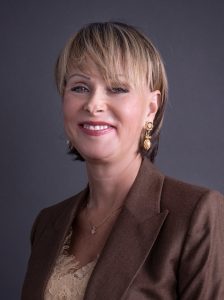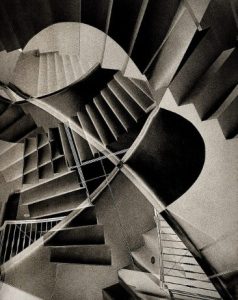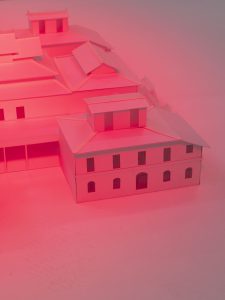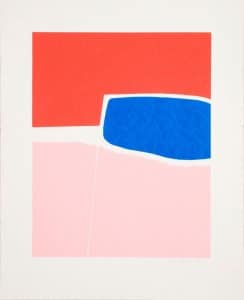 עזים. הצבעים בהדפסים של אלימה חזקים, נקיים, בלתי מתפשרים. הם משטחים המונחים זה ליד זה כמו הצהרה, סדורים כמו שיר בשורות קצרות וקצובות שנדמה שלא יכלו להיות אחרת.הדפס באדום, כחול וורוד (1970) הוא מסע בין הסדור לכאוטי . אלימה הפגישה כחול ואדום, שני צבעי יסוד ליד ורוד מתוק, וקוים (כמעט) ישרים ליד קרעים.
עזים. הצבעים בהדפסים של אלימה חזקים, נקיים, בלתי מתפשרים. הם משטחים המונחים זה ליד זה כמו הצהרה, סדורים כמו שיר בשורות קצרות וקצובות שנדמה שלא יכלו להיות אחרת.הדפס באדום, כחול וורוד (1970) הוא מסע בין הסדור לכאוטי . אלימה הפגישה כחול ואדום, שני צבעי יסוד ליד ורוד מתוק, וקוים (כמעט) ישרים ליד קרעים.
דבר אינו שלם בהדפס, בתוך המשטח הורוד סדק דק מן הדק מבשר שבירה עתידית.
***
קבוצת העבודות המוצגת בגלריה אלמסן ביפו מובחנת היטב: הדפסים שנעשו במהלך השנים 1969 – 1972 וכולם נרכשו בידי ברטה אורדנג ,גלריסטית ומתוות דרך באמנות הישראלית .  אורדנג, סבתה של נטע לאופר, אוצרת התערוכה, ערכה לאלימה את תערוכת היחיד הראשונה שלה. התערוכה הוצגה ב 1960 בגלריה “רינה” שנפתחה שנתיים קודם לכן, מהחללים המעטים בירושלים שהציגו אמנות בת זמנה. אלימה היתה בת עשרים ושמונה וסיימה שלוש שנים קודם את לימודיה ב”אבני”. אורדנג שקידמה אמנות, בעיקר מופשטת בארץ, ואחר כך אמנות ישראלית מופשטת בארה”ב, המשיכה להציג את אלימה במהלך שנות ה 70. ב 1972 הוצגה תערוכת יחיד שלה בגלריה של אורדנג בניו יורק. בהמשך הציגה עבודות של אלימה בתערוכות קבוצתיות של אמנות ישראלית שאצרה במוזיאונים באולבני, אטלנטה ורוצ’סטר.
אורדנג, סבתה של נטע לאופר, אוצרת התערוכה, ערכה לאלימה את תערוכת היחיד הראשונה שלה. התערוכה הוצגה ב 1960 בגלריה “רינה” שנפתחה שנתיים קודם לכן, מהחללים המעטים בירושלים שהציגו אמנות בת זמנה. אלימה היתה בת עשרים ושמונה וסיימה שלוש שנים קודם את לימודיה ב”אבני”. אורדנג שקידמה אמנות, בעיקר מופשטת בארץ, ואחר כך אמנות ישראלית מופשטת בארה”ב, המשיכה להציג את אלימה במהלך שנות ה 70. ב 1972 הוצגה תערוכת יחיד שלה בגלריה של אורדנג בניו יורק. בהמשך הציגה עבודות של אלימה בתערוכות קבוצתיות של אמנות ישראלית שאצרה במוזיאונים באולבני, אטלנטה ורוצ’סטר.
היצירה של אלימה יוצאת דופן בין גופי העבודות שאורדנג קידמה. בין האמנים המזוהים עם השקפת העולם שפיתחה כלפי המופשט והזיקה המיוחדת של אמנים יהודים לסגנון זה היו, קופפרמן, פנחס כהן- גן, יהושע נוישטיין , מיכאל גיטלין בני אפרת ומיכה אולמן. בעוד הם זכו במהלך השנים להכרה נירחבת הרי ההכרה באלימה נותרה מוגבלת. בניסוח מרוכך הוגדרה אלימה לא פעם כ”אמנית של אמנים”. ( לאורך הקרירה הארוכה שלה הציגה שלוש תערוכות יחיד מוזאליות, האחרונה והמקיפה בהן ב 2009 באצירת יניב שפירא).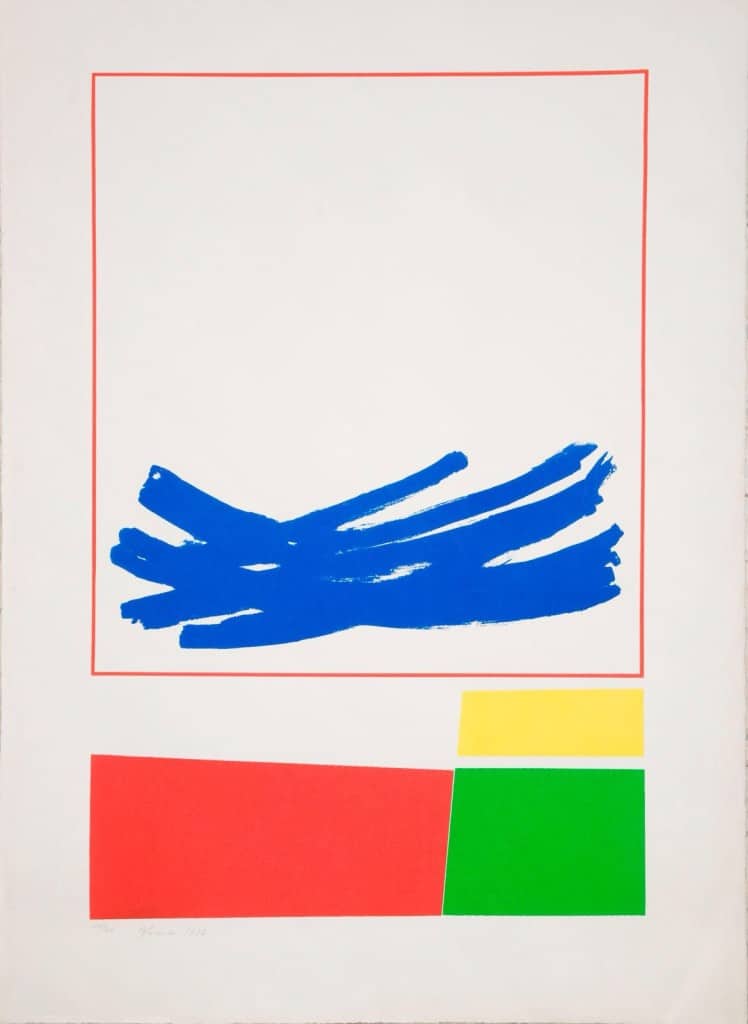
התערוכה הנוכחית אינה המקום לבחון את השאלה עד כמה השוליות היחסית של אלימה אין זה המקום לעמוד עד כמה תרמה לדחיקתה לשוליים היותה אמנית אשה. ההחלטה של לאופר להציג דווקא את גוף העבודות של אלימה מעיזבון אורדנג, ולא אמן אחר שעבודתו שמורות בעיזבון, מאפשר להרהר על ההקבלה שבין אורדנג שפעלה בשדה הגברי מאד של הגלריות בשנות ה 60 וה 70 , מחוייבת למה שכינתה “אמונה” במינמליזם, ובין דרכה של אלימה.
העבודות של אלימה תובעניות- בלא נרטיב וללא סמלים הן אינן מתפענחות בקלות. האסוסיאציות המידיות שהן יוצרות היא למודרניזם על גווניו השונים. מהדהד בהן המודרניזם המוקדם ובמיוחד תורות הצבע, על קירבתן לעיסוק ברוחניות, כפי שבאו לביטוי בעבודות וכתבים של ואסילי קנדינסקי, יוהאנס איטן או מוהלי נאג’. התפיסה של צבע כישות בעלת עוצמה המשפיעה על העולם עולה מתוך העבודות שבמבט ראשון יכולות להראות תמימות ,לפעמים אפילו מתיילדות. ההשפעות של מאטיס (במיוחד מגזרות הנייר המאוחרות שלו) הנס ארפ ופיקסו (אולי גם ג’וזף אלברס וסוניה דלוניי ) ניכרת וכך גם זיקה לעבודות של אמנים אמריקנים בהן קנת נולדנד ובמיוחד אלסוורת קלי. דובר על העבודות של אלימה בעיקר בהקשר הישראלי של השפעת מיכאל גרוס ואורי רייזמן אך בגוף העבודות מעיזבון אורדנג הזיקה לתולדות האמנות הבינלאומית בולטת יותר. נראה שאורדנג, שפועלה כגלריסטית היה על קו תפר שבין המקומי – היהודי והבינלאומי, חיפשה ומצאה בעבודה של אלימה את הרגישויות הללו.
פלאטת הצבעים בעבודות בתערוכה חדה, כמעט מושחזת. בעבודות אחדות נדמה שאפשר לראות את המאמץ שנדרש לזיקוק ההיגד: בעבודה מ 1970 בתוך משטח כחול מוחלט, מרחף ענן של ספק בכחולים שיכולים להקרא כיסודות הצבע שנחשפו או כמו חלום פנימי. החללים הלבנים,הריקים, שנוצרים בעבודה זו ובעבודות נוספות מרתקים. החללים מעוגלים, לעיתים מהדהדים צורות אחרות, יוצרים איזון בין מלא וריק, מדגישים את צבע המצע כצבע, את ההימנעות כמעשה.
רבים קראו וקוראים את העבודות של אלימה בהקשרי נוף. קריאה זו מסתמכת בעיקר על קריאת הצבעים כמיצגים איפיוני טבע – חום אדמה, ירוק צמחיה וכחול כשמים. קריאה זו אמנם אפשרית אך דומה שאינה ממצה כלל את עומק העבודה של אלימה.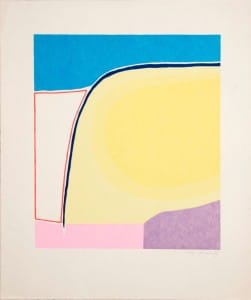
בעיזבון של אורדנג אלימה מיוצגת בהדפסים בלבד. העבודות הן מהשנים הראשונות בהן עסקה בטכניקה זו, איתה הפכה למזוהה. הדפסים, מדיה שיש בה היבט של עשיה מכנית, ודמוקטיזציה מסוימת של היצירה, נחשבה (ונחשבת) בארץ כמישנית, כחסרה את ההילה של מקור. אורדנג עודדה את אלימה על ידי רכישה והצגה של העבודות, תמיכה חד משמעית בנתיב המסוים אותו בחרה.
רוויים בשאלות צורה וצבע , מסתגרים באוטנומיה של האמנות, משמרים ההדפסים, שנוצרו לפני כחמישים שנה, רעננות, כמעט פריכה, תחושה מתעתעת של תהיה ונחרצות.
טקסט תערוכה דר’ סמדר שפי
אוצרת : נטע לאופר
גלריה אלמאסן , הפנינים 1 יפו
לניוזלטר הפירסומי השבועי של “החלון” בנושאי אמנות, אירועים ותערוכות חדשות
www.smadarsheffi.com/?p=925 (הרישום נפרד מהרישום לבלוג )
לפרטים על סיורי אמנות והצטרפות לקבוצה הקבועה כיתבו ל
thewindowartsite@gmail.comPowerful. The colors in Alima’s prints are powerful, clean, and uncompromising. They are surfaces laid down one alongside the other like a declaration, arranged like a poem in short, rhythmic lines which cannot be otherwise.
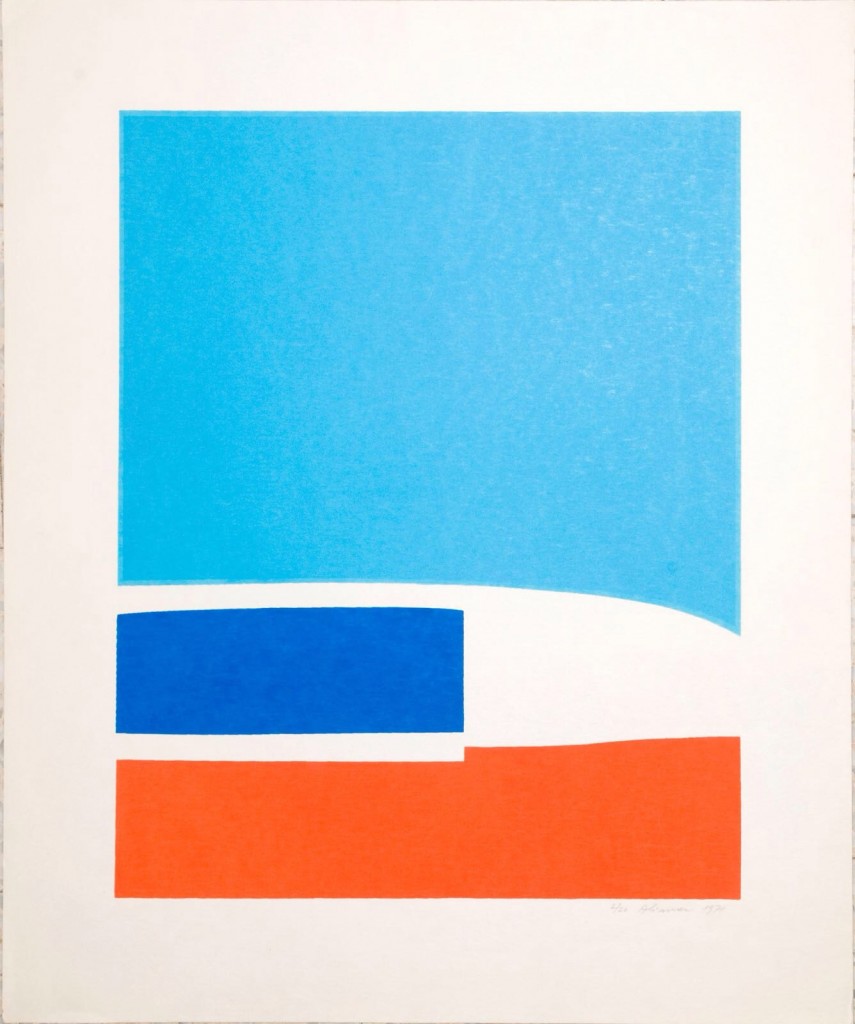 One print in red, blue and pink (1970) is a journey between the orderly and the chaotic. Alima placed two primary colors in a close encounter alongside a saccharine pink, with (nearly) straight lines near torn edges. Nothing in the print is whole. A hairline crack in the pink surface predicts future breakage.
One print in red, blue and pink (1970) is a journey between the orderly and the chaotic. Alima placed two primary colors in a close encounter alongside a saccharine pink, with (nearly) straight lines near torn edges. Nothing in the print is whole. A hairline crack in the pink surface predicts future breakage.
***
The group of prints by Alima on exhibit at the Almacén Gallery in Jaffa are distinct: created 1969-1972, they are from the Estate of Bertha Urdang, gallerist and pathfinder, an important figure in the history of Israeli art. Urdang, the maternal grandmother of Netta Laufer, curator of the current exhibition, hosted Alima’s first one-person exhibition at the Rina Gallery in 1960. Founded in 1958, the Rina Gallery was one of the few venues in Jerusalem to exhibit contemporary art. Alima was 28 years old at the time, having completed her studies at the Avnii Institute of Art, Tel Aviv, only three years earlier. Urdang, who had championed contemporary art in Israel and later abstract Israeli art in the USA, continued to exhibit Alima’s works throughout the 1970s. In 1972, Urdang mounted a one-person show by Alima at her gallery in New York City, and later exhibited Alima’s works in group shows of Israeli art in museum exhibitions she curated in Albany, Atlanta, and Rochester.
Alima’s oeuvre was unusual among the other art that Urdang promoted. Among the Israeli artists identified with the gallery’s outlook, leaning towards abstraction to which so many Jewish artists were linked, were Kupferman, Pinchas Cohen-Gan, Joshua Neustein, Michael Gitlin, Benny Efrat and Micha Ullman. While they received widespread recognition over the years, Alima’s reputation remained limited, and she was frequently labeled as “an artists’ artist.” (Throughout her long career, she had three one-person museum exhibitions, the last and most comprehensive in 2009, curated by Yaniv Shapiro).
The current exhibition is not the place to examine the issue of Alima’s relative marginality, but an opportunity to study to what extent her being a woman was the reason. Laufer’s decision to exhibit Alima’s prints from Urdang’s Estate and not works by another artist provides the opportunity to contemplate possible parallels between Urdang, who operated in a very masculine sphere of art galleries of the ‘60s and ‘70s, committed to what she called her “faith” in Minimalism, and between Alima’s pathway in art.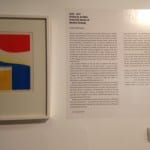
Alima’s works are demanding, devoid of narrative and symbols. They are not easily deciphered. Their immediate associations are to Modernism in its various forms, resonating with Early Modernism and especially Color Theory, close to the engagement with spirituality, as reflected in the works and writings of Kandinsky, Itten, or Moholy-Nagy. The perception of color as a powerful entity impacting the world arises from the works, which at first sight can seem innocent and even childlike. The influence of Matisse (especially his late papercuts), Jean Arp and Picasso (perhaps also Joseph Albers and Sonia Delaunay) are evident, as well as their association to American “color field” artists such as Kenneth Noland and especially Ellsworth Kelly. In the Israeli context, Alima was usually grouped with artists influenced by Michael Gross and Uri Reisman, but in the prints from the Urdang Estate, the association to international art stands out more. It seems that Urdang as a gallerist operating on the seamline between local-Jewish and international, sought and found these sensitivities in Alima’s work.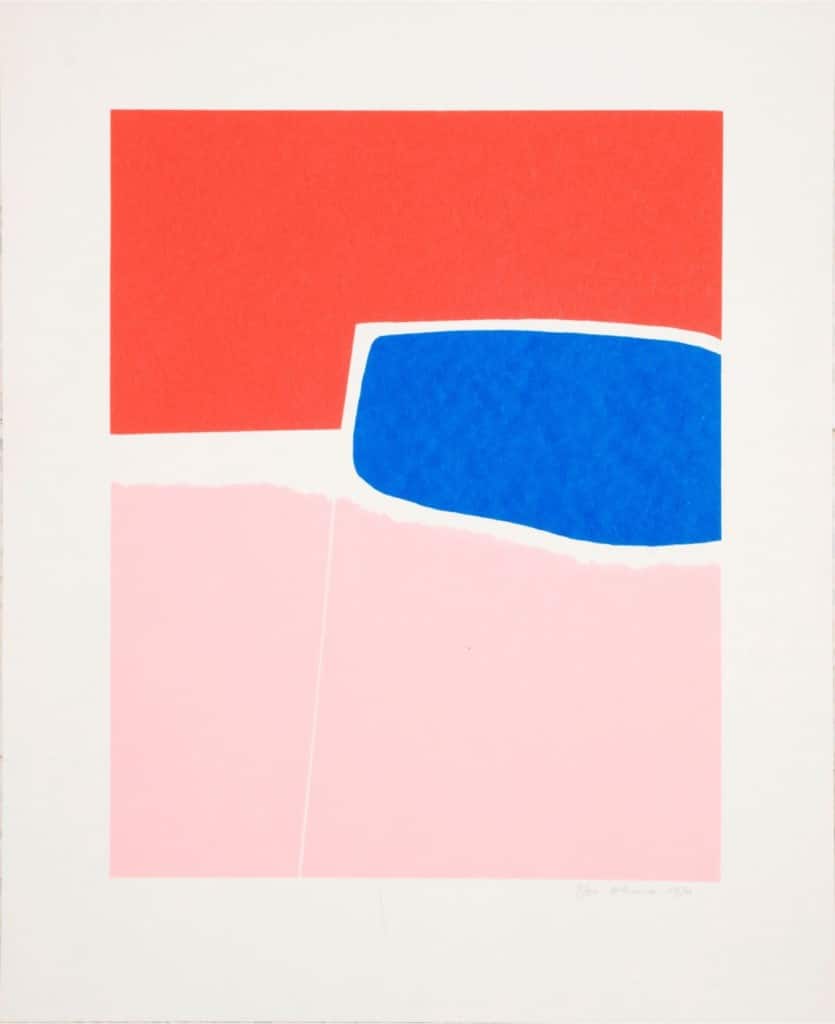
Alima employed a razor-sharp color palette, and distills her statements to the minimum: in one print from 1970, a cloud hovers over a blue surface that can be read as the foundations of color revealed, or like an internal dream. The blank spaces created in this work and others are fascinating, rounded, sometimes resonating with other forms, creating equilibrium between full and empty, emphasizing the color of the surface as paint, and the lack of color as an act of creation. Many people have read Alima’s works as landscapes, based mainly on colors representing elements of nature, such as brown earth, green vegetation and blue sky. Although this is a possibility, it in no way takes into account the depth of her work.
Bertha Urdang’s Estate collected Alima’s prints only. Her early works in this technique became her identifying mark. Printmaking, a medium which has aspects of the mechanical and a certain “democratization” has been (and is) considered “old-fashioned” in Israel, as lacking the aura of the original. Urdang encouraged Alima through the purchase and exhibition of her works, unequivocal support for the particular pathway she chose.
Alima’s prints are suffused with issues of color and form, celebrating their self-containment – the autonomy of art. The prints, made more than five decades ago, maintain their crisp freshness, sense of wonder, and bold determination.
Text Dr. Smadar Sheffi
Curator: Netta Laufer
Almacén Gallery, Hapninim 1, Jaffa.
Join the mailing list for Window’s weekly informational advertising newsletter –
www.smadarsheffi.com/?p=925
For information about Art tours – please write to thewindowartsite@gmail.com

